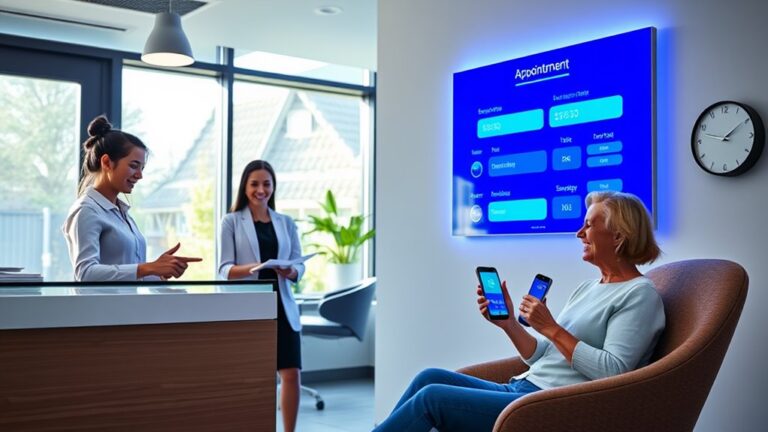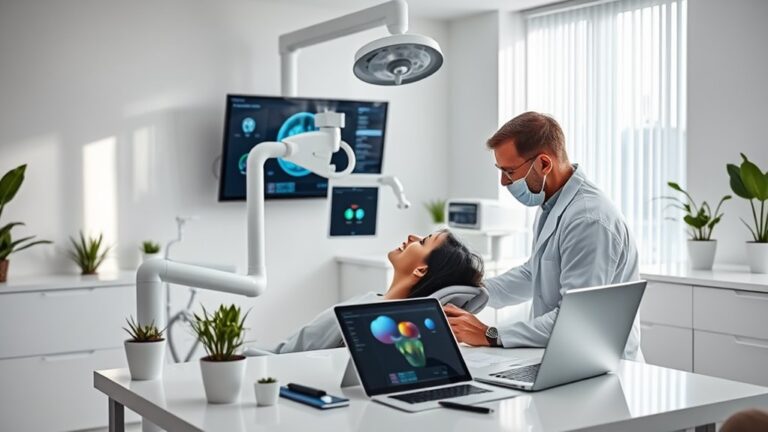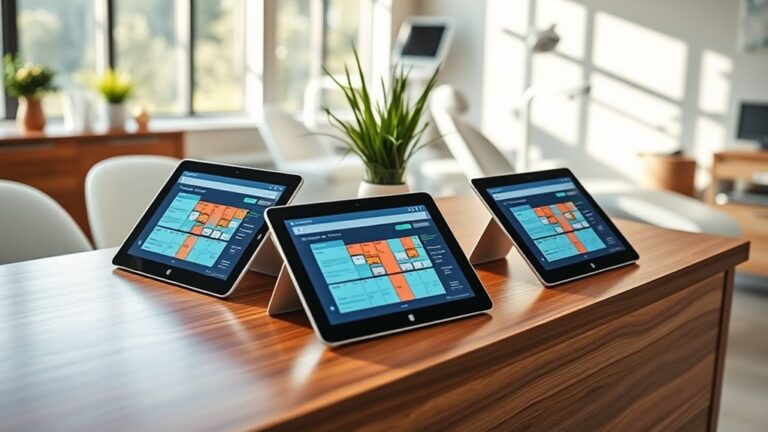5 Best Ways to Automate Patient Scheduling Reminders
Did you know that nearly 30% of scheduled medical appointments result in no-shows, significantly impacting practice efficiency? If you're looking for effective ways to tackle this issue, automating patient scheduling reminders can be your solution. Not only can it help reduce no-show rates, but it can also streamline your administrative processes. There are key strategies that can transform how you engage with patients and ensure they remember their appointments. If you're curious about the best approaches to implement these strategies, feel free to reach out to us. We can connect you with experts who can provide tailored solutions to enhance your patient scheduling process.
Utilize Automated Reminder Systems
Utilizing automated reminder systems can substantially enhance your practice's efficiency and patient engagement. By implementing these systems, you'll experience a significant reduction in administrative burden as staff can focus on delivering quality care instead of managing scheduling conflicts.
Automated communication channels allow you to send reminders via email, text, and voice calls, catering to diverse patient preferences. With features like two-way texting, patients can conveniently confirm, cancel, or reschedule appointments directly. This approach leads to improved patient satisfaction by minimizing no-shows, which cost the healthcare industry billions annually. Automated reminders sent at ideal intervals—one week, one day, and one hour before appointments—ensure that patients are well-informed and prepared. You can also automate rescheduling for canceled appointments, filling valuable slots efficiently. Additionally, many users of automated reminder systems have reported a significant reduction in no-shows, enhancing overall appointment management.
Integrating these systems with your existing data management will streamline administrative processes. By automating appointment status updates and generating reports, you'll monitor effectiveness and identify areas for improvement.
Ultimately, these automated systems not only enhance operational efficiency but also contribute to better patient outcomes and satisfaction, ensuring your practice thrives.
Customize Reminder Templates
Automated reminder systems not only streamline communication but also allow for the customization of reminder templates tailored to specific appointment types. By defining specific reminder messages, you can create tailored communications for various appointments—whether dental, pediatric, or follow-up. Including preparation instructions and relevant details enhances the patient experience. Consider offering personalized messages in multiple languages if your system supports it. Customizable timing is essential. You can set reminders to be sent at various intervals—one week, one day, or even one hour before the appointment. Adjusting the time of day for these reminders guarantees they reach patients when they're most likely to engage. Additionally, you can automate reminders for both pre- and post-visit communications. Incorporating additional resources like questionnaires and procedure instructions can further enrich the reminders. Use the patient's name and specific appointment details to maintain a personal touch, while maintaining branding consistency reflects your facility's values. This approach not only enhances patient engagement but also encourages proactive communication, enabling patients to confirm appointments directly through these personalized messages. The inclusion of appointment details helps ensure that patients have everything they need before their visit.
Integrate Scheduling Tools
Integrating scheduling tools enhances the efficiency of patient management by streamlining appointment reminders and confirmations. By implementing calendar syncing with platforms like Google Calendar, you can automatically send reminders, guaranteeing they're always up-to-date.
With real-time updates, any changes to appointments—be it rescheduling or cancellations—are reflected immediately, reducing the risk of confusion for both you and your patients. This integration ensures that automatic synchronization keeps all parties informed of the latest appointment details.
When you connect your scheduling system with Electronic Health Records (EMRs), you gain the ability to automate reminders securely and efficiently. This integration allows you to read appointment details directly from EMRs and customize reminders via call, text, or email, aligning with patient preferences.
Utilizing web interfaces and online portals further enhances patient engagement. These user-friendly tools provide real-time notifications, enabling you to track responses and manage client details securely.
Additionally, bulk scheduling options, like uploading Excel or CSV files, simplify the process of sending out reminders, while automated reminder setups guarantee consistency.
Leverage AI for No-Show Prediction
As patient scheduling tools become more advanced, leveraging AI for no-show prediction is a logical next step in optimizing appointment management.
AI integration employs predictive analytics that utilizes historical appointment data to train models, achieving up to 90% accuracy in forecasting patient no-shows. By applying supervised learning algorithms like Logistic Regression and Decision Trees, you can identify key factors linked to no-shows, including patient history and appointment specifics. Furthermore, patient no-shows cost the US healthcare system over $150 billion annually, highlighting the importance of effective scheduling strategies.
Moreover, integrating patient data with appointment details enhances insights into patterns that might elude human schedulers. Unsupervised learning techniques like K-means clustering further refine your understanding of patient clusters, allowing for a more tailored approach to scheduling.
The actionable insights derived from these analyses help pinpoint high-risk appointments, enabling you to develop targeted reminder strategies. Personalizing communication based on individual patient histories guarantees that you're addressing their specific needs effectively.
Enhance Patient Engagement Features
To enhance patient engagement features effectively, healthcare providers must prioritize personalized communication and streamlined workflows. By recognizing patient preferences and incorporating technology, you can substantially improve health literacy and overall patient satisfaction.
Consider implementing these strategies:
- Custom Reminder Sequences: Tailor reminders to fit the unique needs of each patient, ensuring relevance and effectiveness.
- Preferred Communication Channels: Use text messages, as patients often prefer their visibility and convenience, while ensuring HIPAA compliance.
- Educational Content: Provide personalized educational resources that cater to individual learning styles and health goals.
By integrating these features with health record systems, you'll create a seamless flow of information that enhances patient engagement. Engaged patients are more likely to make better long-term health choices, which ultimately benefits their overall well-being.
Foster shared decision-making by involving patients in their care, using decision aids that clarify options and outcomes.
Regularly solicit feedback to identify areas for improvement and empower patients as stakeholders in their health journey.
Ultimately, enhancing patient engagement involves a commitment to understanding each patient's unique needs, preferences, and health literacy, ensuring they feel informed and valued throughout their care experience.
Frequently Asked Questions
What Types of Reminders Can Be Automated?
You can automate various reminder types, including appointment types and insurance verifications. Personalization options enhance engagement by tailoring messages based on patient data, ensuring each reminder is relevant and informative for the recipient.
How Secure Is Patient Data in Automated Systems?
While automated systems enhance efficiency, they also need robust security. You'll find data encryption and strict access controls crucial for safeguarding patient information, ensuring that only authorized personnel can access sensitive data, maintaining trust in healthcare.
Can Reminders Be Sent in Multiple Languages?
Yes, you can send reminders in multiple languages. By incorporating patients' language preferences and demonstrating cultural sensitivity, you enhance communication effectiveness, improve engagement, and reduce no-shows, ultimately fostering a more inclusive healthcare experience.
What Devices Can Receive Automated Reminders?
Over 90% of patients use mobile devices like smartphones and tablets, which can receive automated reminders via SMS or push notifications. Additionally, landline phones and desktops can also deliver these critical reminders effectively.
How Can Patients Opt Out of Reminders?
To opt out of reminders, you can use various methods. Make certain you understand consent requirements, like responding to messages or adjusting settings in your profile. It is crucial to maintain control over your communication preferences.
Conclusion
Incorporating these automation strategies can transform your patient scheduling process into a seamless, well-oiled machine. Imagine a world where reminders fly into patients' inboxes and phones like shooting stars, ensuring no one forgets their appointment. With customized templates and real-time integrations, you'll experience a reduction in no-shows so significant, it'll feel like you've discovered the secret to patient engagement.
If you're feeling overwhelmed or unsure about implementing these tools, don't hesitate to reach out to us for assistance. Our expert help can save you valuable time, reduce stress, and significantly improve your dental practice. Embrace these strategies with our guidance, and watch your practice thrive in a symphony of efficiency and patient satisfaction.





